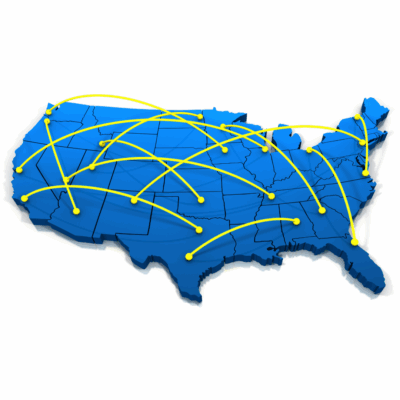5 Things to Consider When Hiring Across State Lines
In today’s digitized world, talent knows no boundaries.
Employers are increasingly looking beyond their local talent pool to consider candidates from other states to fill critical roles—a trend undoubtedly solidified by the pandemic during which companies adopted remote work policies and capabilities that made it possible to consider candidates from other geographical locations.
Hiring across state lines opens the door for greater hiring opportunities. For example, tech companies can now hire top engineering talent from tech hubs outside their region.
Similarly, companies located in expensive areas—where salaries run high and office space is pricey—can seek less expensive customer service talent in more affordable areas to help their bottom line.
But, while hiring across state lines opens up new opportunities for employers regarding the quality of talent, skill sets, cost-saving, and influence in new markets, it also brings up new challenges for human resources. Below are the top considerations to keep in mind when opening hiring to more states.
Legal Considerations: State-by-State Compliance
Different states have varying employment laws around hiring, payroll, wages, benefits, and more. HR professionals must familiarize themselves with the employment laws of the states they want to hire before posting a job ad in those locations—and must stay current on any updates or changes to those laws to remain compliant.
For example, some states enforce ban-the-box legislation to promote fairer hiring practices, meaning employers can’t ask about or check criminal backgrounds during the hiring process. Other states won’t allow companies to ask about a candidate’s salary history during the hiring process, only allowing them to inquire about salary expectations.
Regarding pay, each state has different minimum wage requirements that out-of-state employers must adhere to, different regulations around payday frequency (weekly, bi-weekly, monthly), and other unique pay-related mandates.
Employers must also consult state laws to determine legal obligations for breaks, time off, and workers’ compensation to ensure they don’t unintentionally break any rules in the state where a potential hire might live.
Tax Considerations
Working across state lines can complicate tax withholding and reporting. HR professionals should consult their finance department and/or tax advisor to understand the implications of hiring in certain states for both the employer and the employee, and consider the following:
- State Tax ID: All employers have a Federal Tax ID or Employee Identification Number (EIN) to pay Federal taxes. Similarly, employers may need a State Tax ID Number to pay state taxes for sales, withholding, and unemployment. Whether a company needs a State Tax ID in a certain state usually depends on legislation surrounding income and employment taxes in that state.
- Income Tax Withholding: Generally speaking, most businesses must withhold income tax in the state(s) where their employees work. Consequently, if an employer hires an out-of-state employee, they withhold state taxes based on where the employee resides––not the taxes where the business resides. However, there are some exceptions, and it’s up to HR professionals to get familiar with these requirements before opening hiring up in new markets.
- Unemployment Tax: In the same way employers must pay Federal unemployment taxes, each state also has its own unemployment tax program that out-of-state employers must adhere to. These programs often impact where the tax burden falls: the employer or the employee.
- Other Tax Considerations: Employers should also look out for state tax requirements around workers’ compensation (mandatory in all states except Texas), disability insurance, or paid family and medical leave (which some states treat as a tax).
Recruiting and Screening Considerations
Hiring across state lines makes it more difficult to vet, evaluate, and screen candidates effectively.
More coordination is involved in getting a candidate through the hiring process, making it nearly impossible for hiring managers to dot their I’s and cross their T’s (especially when candidates expect a quick and easy hiring process). Interviews conducted remotely also make getting an accurate read on a candidate harder, increasing the risk of making a bad hire.
More companies increasingly use professional background checks to manage that risk and make higher-quality out-of-state hires. In fact, upwards of 95% of employers are conducting some kind of pre-employment screening today.
However, each state has a different set of rules regarding background screening—and those laws are constantly changing at both a city-wide and state-wide level.
Plus, employers conducting background screening out-of-state must comply with screening laws in the employer’s and the candidate’s states, further complicating things. The result is a lot of extra research and additional paperwork for recruiting and HR professionals.
To unlock the risk-reduction powers of background screening while navigating the complexity of compliance when hiring out of state, HR should team up with an accredited, professional background screening agency, like S2Verify.
Through a thorough understanding of geographical and industry regulations, we help employers stay compliant–while also detecting threats–so they can make hires that are more likely to stay and less likely to put the business at risk.
Compensation Considerations
Hiring across state lines naturally raises questions around pay: should employers pay a remote worker the same rate as a local one? Or, should they adjust based on market rate? What is the cost of living in that state? What is considered competitive pay in that region? And so on…
Unsurprisingly, every organization has a different philosophy for approaching these questions and structuring remote pay. Some organizations pay all employees, everywhere, the same salaries, while others adjust salaries based on the cost of living. Some even create original salary calculations and formulas to standardize salary adjustments for all hires nationwide.
Employers should consider their unique company culture and their competitiveness in each market when determining what’s right for them in how they structure pay for out-of-state employees.
Communication and Culture Considerations
On that note, out-of-state hiring poses a threat to company culture. In a remote work model, it can be difficult to recreate the connections employees build in traditional, face-to-face workplace environments—resulting in reduced engagement and satisfaction.
According to Gallup, companies with engaged employees benefit from lower absenteeism and employee churn and enjoy increased profitability, productivity, and even customer engagement.
That means employers that open up hiring to other states must proceed with the utmost caution regarding how they interact with remote employees throughout the employee lifecycle—focusing on keeping them consistently engaged and integrated with company culture.
Successful out-of-state hiring starts with quality onboarding (since 69% of employees are more likely to stay with a company for three years if they experience a great onboarding process), and continues with regular virtual check-ins and team-building events that further integrate remote employees into the company.
Finally, quality, consistent communication (and, sometimes, overcommunication) will keep everyone on the same page regardless of location.







